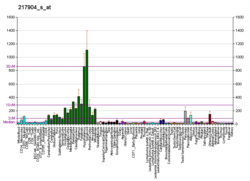Beta-secretase 1, also known as beta-site amyloid precursor protein cleaving enzyme 1, beta-site APP cleaving enzyme 1 (BACE1), membrane-associated aspartic protease 2, memapsin-2, aspartyl protease 2, and ASP2, is an enzyme that in humans is encoded by the BACE1 gene.[5] Expression of BACE1 is observed mainly in neurons and oligodendrocytes.[6]
BACE1 is an aspartic acid protease important in the formation of myelin sheaths in peripheral nerve cells: in mice the expression of BACE1 is high in the postnatal stages, when myelination occurs.[7] The transmembrane protein contains two active site aspartate residues in its extracellular protein domain and may function as a dimer, its cytoplasmic tail is required for the correct maturation and an efficient intracellular trafficking, but does not affect the activity. It is produced as a pro-enzyme, the endoproteolitc removal occurs after BACE leaves endoplasmic reticulum, in the Golgi apparatus. In addition the pro-peptide receives additional sugars to increase the molecular mass.[8] and the tail became a palmitoylated.[citation needed]
The BACE1 expression is influenced by the inflammatory state: during AD the cytokines reduce the PPAR1 an inhibitor of BACE1 mRNA.[citation needed]
- ^ a b c GRCh38: Ensembl release 89: ENSG00000186318 – Ensembl, May 2017
- ^ a b c GRCm38: Ensembl release 89: ENSMUSG00000032086 – Ensembl, May 2017
- ^ "Human PubMed Reference:". National Center for Biotechnology Information, U.S. National Library of Medicine.
- ^ "Mouse PubMed Reference:". National Center for Biotechnology Information, U.S. National Library of Medicine.
- ^ Vassar R, Bennett BD, Babu-Khan S, Kahn S, Mendiaz EA, Denis P, Teplow DB, Ross S, Amarante P, Loeloff R, Luo Y, Fisher S, Fuller J, Edenson S, Lile J, Jarosinski MA, Biere AL, Curran E, Burgess T, Louis JC, Collins F, Treanor J, Rogers G, Citron M (Oct 1999). "Beta-secretase cleavage of Alzheimer's amyloid precursor protein by the transmembrane aspartic protease BACE". Science. 286 (5440): 735–41. doi:10.1126/science.286.5440.735. PMID 10531052. S2CID 42481897. Archived from the original on 2019-04-09. Retrieved 2019-07-01.
- ^ Rajani RM, Ellingford R, Hellmuth M, Harris SS, Taso OS, Graykowski D, Lam F, Arber C, Fertan E, Danial J, Swire M, Lloyd M, Giovannucci TA, Bourdenx M, Klenerman D, Vassar R, Wray S, Sala Frigerio C, Busche MA (July 2024). "Selective suppression of oligodendrocyte-derived amyloid beta rescues neuronal dysfunction in Alzheimer's disease". PLOS Biology. 22 (7): e3002727. doi:10.1371/journal.pbio.3002727. PMC 11265669. PMID 39042667.
- ^ Willem M, Garratt AN, Novak B, Citron M, Kaufmann S, Rittger A, DeStrooper B, Saftig P, Birchmeier C, Haass C (Oct 2006). "Control of peripheral nerve myelination by the beta-secretase BACE1". Science. 314 (5799): 664–6. Bibcode:2006Sci...314..664W. doi:10.1126/science.1132341. PMID 16990514. S2CID 8432207.
- Lay summary in: Phillips ML (September 21, 2006). "Alzheimer's enzyme important for myelin". The Scientist.
- ^ Capell A, Steiner H, Willem M, Kaiser H, Meyer C, Walter J, Lammich S, Multhaup G, Haass C (2000-10-06). "Maturation and Pro-peptide Cleavage of β-Secretase". Journal of Biological Chemistry. 275 (40): 30849–30854. doi:10.1074/jbc.M003202200. ISSN 0021-9258. PMID 10801872.





